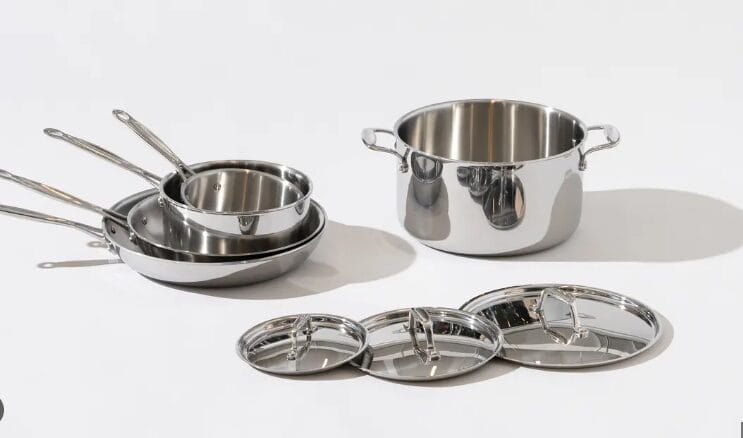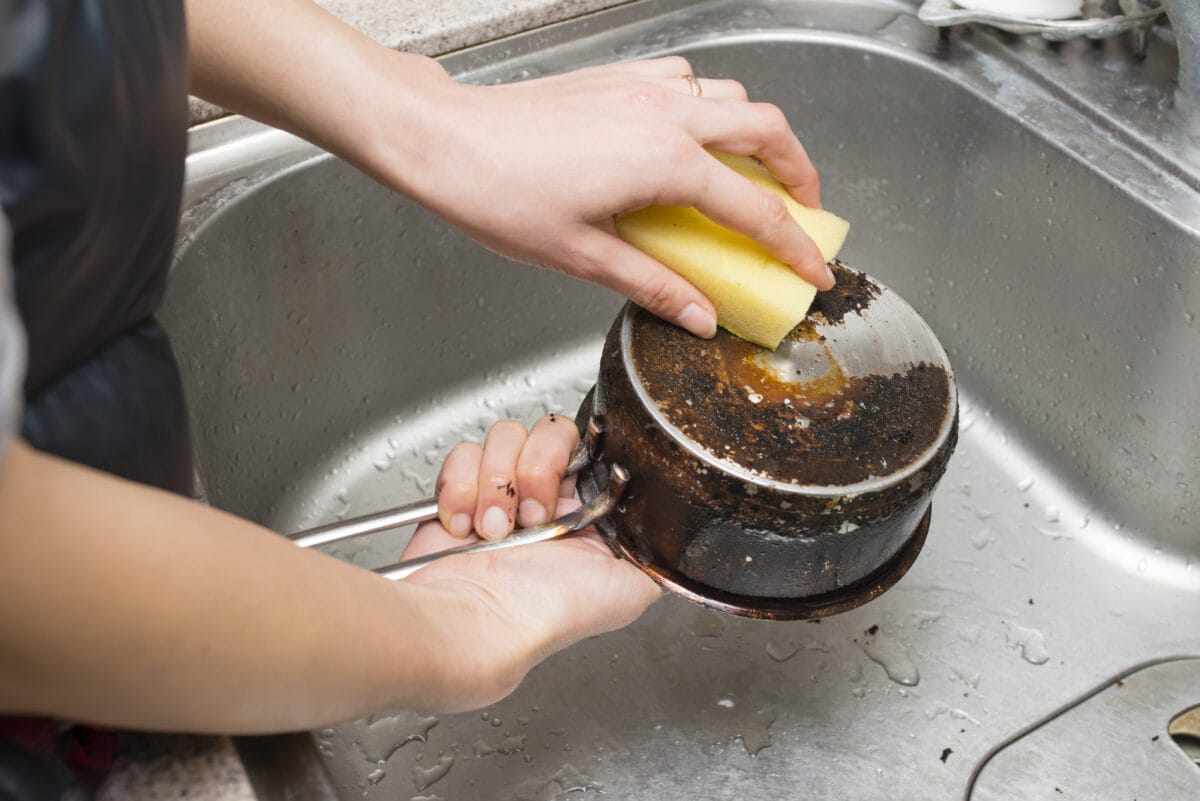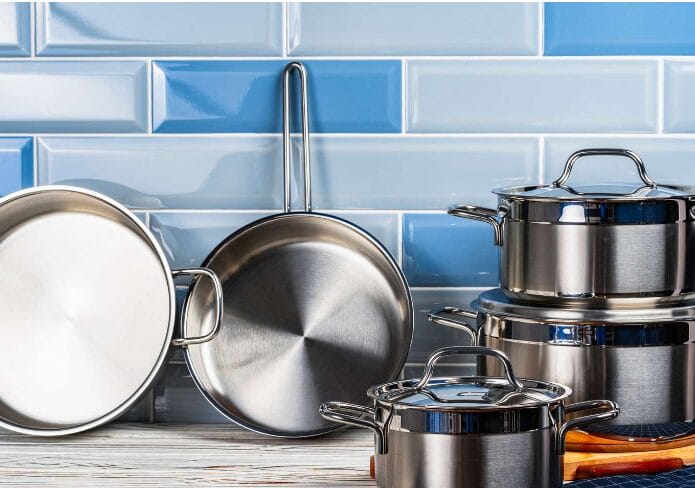In your kitchen, you likely have an assortment of cookware crafted from diverse materials. One common type is nonstick cookware, often featuring a Teflon coating, combined with various metals such as aluminum and stainless steel. While aluminum and stainless steel cookware may appear similar at first glance, they possess distinctive characteristics that merit attention.
Given the concerns and inquiries surrounding aluminum cookware, particularly its alleged connection to Alzheimer’s Disease, this article of Food and Meal aims to address the fundamental question: “Is it safe to cook with aluminum cookware?”
Let’s delve into the intricacies. This piece will explore the safety aspects of using aluminum cookware, different types available in the market, and practical suggestions to minimize your exposure to aluminum from cookware. To commence, we’ll dissect the health considerations associated with aluminum cookware, offering a balanced perspective without resorting to forceful language.
It’s important to acknowledge the nuanced nature of this topic, as understanding the potential health implications of aluminum cookware requires careful examination and consideration. So, let’s embark on this journey, shedding light on the facts and dispelling any misconceptions along the way.
Aluminum Cookware Dangers
Aluminum cookware has claimed its place in the kitchen due to its exemplary heat conductivity, feather-light build, and wallet-friendly price tag, making it a mainstay for creating culinary tools from pots and pans to bakeware. Wander into any store or domestic kitchen, and the presence of aluminum’s silvery shine is nearly guaranteed. Yet, as with many widespread staples, rising tides of concern have cast aluminum cookware in a somber light, with whispers of health perils causing a stir amongst consumers.
This unease sprouted from roots planted in 1965 when studies on experimental animals unearthed aluminum’s neurotoxic potential—setting scientists on a quest to unfurl any ties this element may have to Alzheimer’s Disease and its kin in the realm of neurological disorders. The trail, however, has been as winding and indistinct as the branches of a neuron itself. While cautionary tales have circulated, the direct correlation between aluminum cookware and Alzheimer’s remains unconfirmed, hanging in ambiguity.
To put things in perspective and temper alarm, consider the findings pointing out that aluminum’s daily dance into our diets through cookware contributes but a trivial act to the overall show. Take the Canadian populace, for example, whose estimated daily aluminum intake is suggested around 10 milligrams, with a mere 1-2 milligrams attributed to the cooking instruments in question. It’s a fraction so minimal it’s almost lost in the dietary shuffle.
Moreover, the World Health Organization ushers in a dose of reassurance, estimating that humans can ingest over 50 milligrams of aluminum each day without adverse effects. Thus, pertaining to Alzheimer’s Disease, the connection to aluminum is analogous to a jigsaw puzzle with pieces lost in time—there’s a semblance of an image, but the clarity we crave escapes us.
In essence, while the ghost of uncertainty still drifts through scientific corridors, for now, the verdict on aluminum cookware’s potential for harm remains a tale told in hushed tones rather than thunderous declarations.

Can Aluminum Leach From Aluminum Cookware?
Aluminum’s presence in our kitchens is as commonplace as salt and pepper, with its commendable heat distribution and airy ease of handling shaping our cookware collections. Yet, in the crucible of cooking, especially under the duress of high temperatures, this seemingly benign metal has a tendency to seep into the very food we consume, subtly insinuating itself into our daily fare.
The act of cooking, particularly when engaging with acidic provisions like the tang of tomatoes or the zestful bite of citrus, coerces aluminum to relinquish its hold, melding into meals perhaps more intently than we might invite. The conversation then simmers down to quantifying this metallic migration – how much aluminum actually finds its way from pan to plate?
Thankfully, the levels of aluminum that make the journey are generally small – termed trace amounts – mere specks on the vast canvas of our diets. In bodies brimming with health, our internal alchemy, a complex interplay of processes, typically filters out this unbidden guest. Like any thoroughfare of detoxification, efficiency varies, etched deeply by the enigmatic codes of genetics among other variables.
Thus armed with this knowledge, though the quantities may be inconsequential for most, prudence whispers a word of caution: steer away from aluminum’s invisible embrace when you can. In the grand tapestry of cooking and consumption, it’s the unwoven threads – the unseen elements – that often urge a second glance, compelling us to minimize unnecessary mingling with aluminum, lest it become an unwanted seasoning to our sustenance.
Is Anodized Aluminum Cookware Safer?
Anodized aluminum cookware presents a fusion of ingenuity and practical design, addressing the innate concerns associated with traditional aluminum cookware through a transformative process called anodization. When aluminum is submerged in an acid electrolyte bath and subjected to an electrical current, a rugged layer of aluminum oxide forms over its surface. This hardened layer stands sentinel over the underlying metal, a noble guard against the typical wear and tear that cookware faces.
The virtues of anodized aluminum are many. It steadfastly resists corrosion, laughs in the face of scratches, and reduces reactivity with foods prone to stick or pick up metallic traces — effectively lowering the risk of aluminum leaching into our meals. Beyond safety, its heat conduction prowess remains unhampered, it boasts remarkable durability, and the ease of maintenance is a whispered promise of stress-free cleanup.
Yet, amidst these benefits, we must gingerly tread. The aluminum oxide layer, while staunch, is not an eternal shield; it may yield to time and usage. Attention to the manufacturer’s guidance ensures longevity and proper care. And while our culinary journey quests for materials untainted by toxicity, the charade of whether the anodized coat will rise as a non-toxic champion continues. For now, we can enjoy its current merits while remaining vigilant about the long-term effects of cooking surfaces on our health.

Is Aluminum Club Cookware A Good Option?
Club aluminum cookware boasts a robust construction, achieved through the meticulous stratification of aluminum into multiple layers. This design choice lends it a heft and resilience that draws parallels to the revered heavy-duty culinary implements favored by chefs far and wide.
Despite its widespread use, a shroud of mystery envelops the full extent of this cookware’s safety profile. The nature of the materials chosen to accompany aluminum through this layering process dictates not only its performance under the heat of the kitchen’s fervor but also its potential for chemical interplay with the food it cradles.
For those whose gaze is captured by the allure of club aluminum cookware, an odyssey of enlightenment beckons. Dive deep into the essence of what substances imbue these layers with form and function; unravel the procedures that sculpt them into vessels of culinary creation. Most critically, cast a discerning eye upon the behaviors these materials may exhibit when kissed by flame and their propensity to whisk traces of themselves into the meals you nurture within them.
Cooking With Aluminum Foil
Club aluminum cookware boasts a robust construction, achieved through the meticulous stratification of aluminum into multiple layers. This design choice lends it a heft and resilience that draws parallels to the revered heavy-duty culinary implements favored by chefs far and wide.
Despite its widespread use, a shroud of mystery envelops the full extent of this cookware’s safety profile. The nature of the materials chosen to accompany aluminum through this layering process dictates not only its performance under the heat of the kitchen’s fervor but also its potential for chemical interplay with the food it cradles.
For those whose gaze is captured by the allure of club aluminum cookware, an odyssey of enlightenment beckons. Dive deep into the essence of what substances imbue these layers with form and function; unravel the procedures that sculpt them into vessels of culinary creation. Most critically, cast a discerning eye upon the behaviors these materials may exhibit when kissed by flame and their propensity to whisk traces of themselves into the meals you nurture within them.

Aluminum vs Stainless Steel Cookware
Aluminum and stainless steel cookware both bring their unique strengths to the kitchen, catering to a wide range of culinary needs with their lightness and heat-conducting prowess. Indeed, aluminum shines as a thermal conductor, swiftly and uniformly transferring heat, making it an excellent ally when even cooking is paramount. In the world of cost-effective, high-temperature-friendly options, both materials hold their ground commendably.
Yet, when safety enters the conversation, stainless steel often takes the spotlight. It has sidestepped much of the debate surrounding aluminum cookware—particularly the concerns regarding neurotoxicity and the potential link to Alzheimer’s disease. This is one of the reasons why, personally, my kitchen brims with the reflective gleam of stainless steel pots and pans. I find solace in their lack of controversy and their reputation for being a safe, non-toxic choice for everyday cooking.
With attention to the guidelines detailed in the article, each type of cookware can serve its purpose safely and effectively. Stainless steel’s resistance to rust and corrosion, coupled with its indifference to acidic foods, grants it a level of universality in cooking tasks. Meanwhile, those who opt for aluminum cookware can enjoy its benefits too, keeping in mind its interaction with highly acidic or alkaline foods and the importance of proper maintenance to prevent wear of any protective layers such as those provided by anodization.
In selecting between the two, it boils down to personal preference, cooking style, and an informed approach to material-specific considerations that ensure a wholesome and healthy cooking environment.
Cooking With Aluminum Cookware And Other Tips
Aluminum cookware, while a subject of some debate, is generally considered safe for use under proper conditions. Here are some tips to help reduce aluminum exposure when using aluminum cookware:
- Opt for anodized aluminum cookware: An anodized surface offers a protective layer that reduces the likelihood of aluminum leaching into your food, thereby reducing contamination in your diet.
- Know what’s in the protective layer: Research the materials used in the anodization process to ensure they do not pose their own risks and determine if there are any specific cooking circumstances that could lead to contamination.
- Adhere to care instructions: Follow the manufacturer’s guidelines for maintaining the anodized layer so it continues to protect against leaching. Proper maintenance prolongs both the life and safety of your cookware.
- Use appropriate utensils and cleaning methods: Avoid metal utensils, which can scratch the anodized surface. Instead, opt for silicone or wooden tools. Also, steer clear of abrasive cleaning pads to prevent wearing down the protective coating.
- Retire damaged cookware: If your anodized aluminum cookware is showing signs of wear or damage, such as deep scratches or peeling, it’s best to discard it since damaged surfaces may increase aluminum leaching during cooking.
- Limit contact time with aluminum: The amount of aluminum that leaches into food can increase the longer the food is in contact with the material, so aim to minimize this contact time during cooking and storage.
- Consider the type of food you’re cooking: Foods that are high in acidity or that are leafy vegetables tend to absorb more aluminum. When preparing such foods, it’s particularly wise to use alternatives or anodized aluminum to limit aluminum uptake.
For those looking to avoid aluminum altogether, especially when storing food or using foil, alternatives like wax paper, parchment paper, and glass containers offer a safe and suitable option.
Conclusion
To recap, there exist various varieties of aluminum cookware, ranging from uncoated aluminum and anodized aluminum to aluminum club cookware and aluminum foil. The safety of aluminum cookware depends significantly on the type, with anodized aluminum cookware considered potentially the safest, contingent on the composition of its coating.
With mindfulness and proper consideration, cooking with aluminum can indeed be a safe practice.
I'm Kelly Atkinson, with a passion for dissecting the world of home goods. My reviews stem from thorough testing and a love for sharing detailed insights. Each piece I write offers a glimpse into my explorative journey, aiming to guide readers to informed choices with authenticity and precision, making every review a blend of exploration and expertise.
